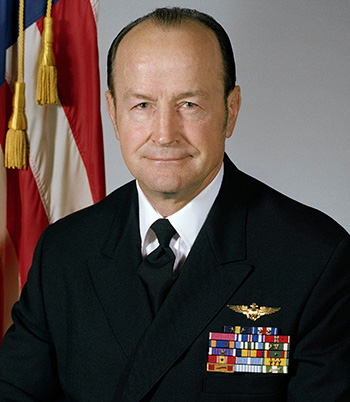
|
William P. "Bill" Lawrence |
 |
|||
| Rank, Service | ||||
Vice Admiral O-9, U.S. Navy |
||||
| Veteran of: | ||||
|
||||
| Tribute: | ||||
Bill Lawrence was born on January 13, 1930, in Nashville, Tennessee. He entered the U.S. Naval Academy in July 1947 and he was commissioned an Ensign in the U.S. Navy on June 1, 1951. Ens Lawrence continued on at the Academy as Aide to the Commandant until September 1951, and then attended flight training, earning his designation as a Naval Aviator in November 1952. After completing advanced flight training, All Weather Flight School, and Jet Training, Lt Lawrence served as an F2H Banshee pilot with VF-193 at NAS Moffett Field, California, from March 1953 to October 1955. During this time, he deployed to Korea aboard the aircraft carrier USS Oriskany (CVA-34) from March to April 1953. He then attended the Aviation Safety University of Southern California from October to December 1955, followed by Test Pilot School at NAS Patuxent River, Maryland, from January to August 1956. His next assignment was as a Project Pilot at Pax River from August 1956 to November 1958, and then as a Flight Instructor and Assistant Operations Officer at the Test Pilot School from November 1958 to May 1959. During this time, Lt Lawrence became the first Navy pilot to fly twice the speed of sound in a production Navy aircraft, and he was a Navy nominee for the initial NASA Astronaut selection and was one of the final 32 candidates for Project Mercury. He then served as a Flag Lieutenant and Safety Officer with Carrier Division 6 from June 1959 to October 1960, followed by service as Assistant Operations Officer with VF-101 at NAS Oceana, Virginia, from October 1960 to June 1961. LCDR Lawrence next served as Navigator aboard the heavy cruiser USS Newport News (CA-148) from June 1961 to July 1962, and then completed F-4 Phantom II Replacement Air Group training with VF-101 from July to November 1962. His next assignment was as Maintenance Officer with VF-14 at NAS Cecil Field, Florida, from November 1962 to January 1964, and then as Aide to the Commander in Chief of U.S. Strike Command at MacDill AFB, Florida, from February 1964 to February 1966. CDR Lawrence then completed F-4 RAG training with VF-121 from February to July 1966, followed by service as Executive Officer and then Commanding Officer of VF-143 from July 1966 until he was forced to eject over North Vietnam and was taken as a Prisoner of War on June 28, 1967. After spending 2,077 days in captivity, Capt Lawrence was released during Operation Homecoming on March 4, 1973. He was briefly hospitalized to recover from his injuries at the Naval Hospital in Memphis, Tennessee, from March to August 1973, and then attended National War College from August 1973 to July 1974. RADM Lawrence next served as Commander of Light Attack Wing, U.S. Pacific Fleet, at NAS Lemoore, California, from July 1974 to May 1975, followed by service as Director of the Aviation Programs Division in the Office of the Chief of Naval Operations in the Pentagon from May 1975 to June 1977. He then served as Assistant Deputy Chief of Naval Operations for Air Warfare at the Pentagon from July 1977 to August 1978. VADM Lawrence next served as Superintendent of the U.S. Naval Academy from August 1978 to August 1981, followed by service as Commander of U.S. Third Fleet from September 1981 to September 1983. His final assignment was as Deputy Chief of Naval Operations for Manpower, Personnel and Training and Chief of Naval Personnel from September 1983 until his retirement from the Navy on February 1, 1986. Bill met and married Diane Wilcox after his return from Vietnam in 1973. Bill Lawrence Flew West on December 2, 2005, and was buried at the U.S. Naval Academy Cemetery in Annapolis, Maryland. The Aegis Guided Missile Destroyer USS William P. Lawrence (DDG-110) was named in his honor. |
||||
|
||||

